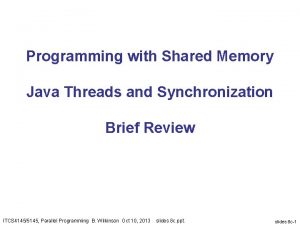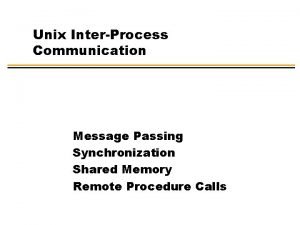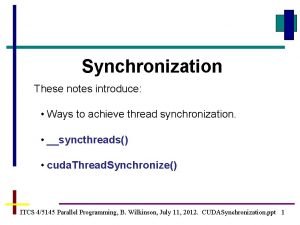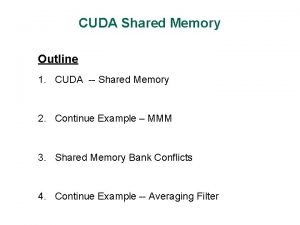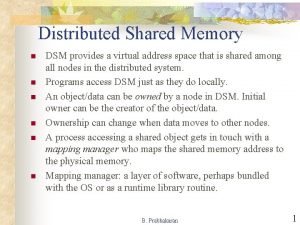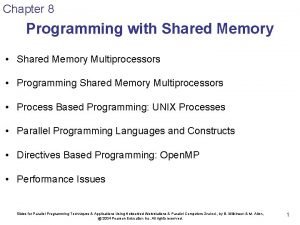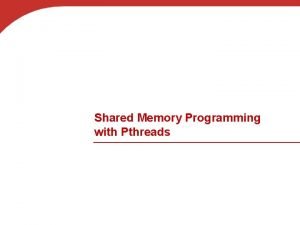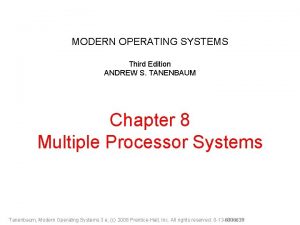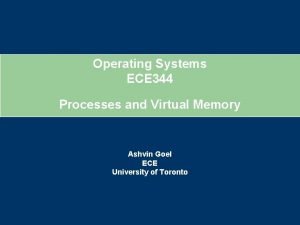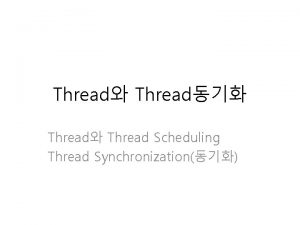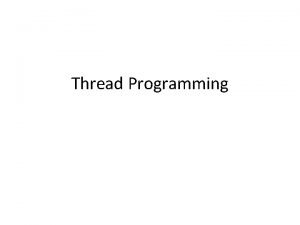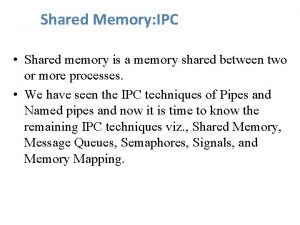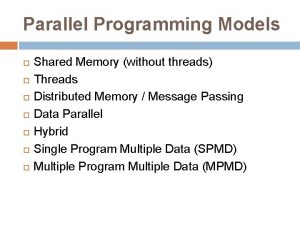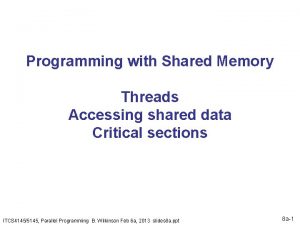Synchronization Shared Memory Thread Synchronization Threads cooperate in




























- Slides: 28

Synchronization

Shared Memory Thread Synchronization • Threads cooperate in multithreaded environments – User threads and kernel threads – Share resources and data structures • E. g. memory cache in a web server – Coordinate execution • Producer/consumer model • For correctness, cooperation must be controlled – Must assume threads interleave execution arbitrarily • Scheduler cannot know everything – Control mechanism: synchronization • Allows restriction of interleaving • Note: This is a global issue (kernel and user) – Also in distributed systems

Shared Resources • Our focus: Coordinating access to shared resource • Basic Problem: – Two concurrent threads access a shared variable – Access methods: Read-Modify-Write • Two levels of approach: – Mechanisms for control • Low level locks • Higher level mutexes, semaphores, monitors, condition variables – Patterns for coordinating access • Bounded buffer, producer/consumer, …

The Classic Example • Managing a bank account: int balance; void deposit(int amount) { balance += amount; } int withdraw(int amount){ balance -= amount; return balance; } • Suppose account is shared between 2 people – What happens if both people go to ATMS and deposit $$?

Cooperating Requires Synchronization • Deposit implemented as sequence of ASM instructions void deposit(int amount) { balance += amount; } Load R 1, balance Add R 1, amount Store R 1, balance • What happens if two processes call deposit at same time? Process 1 Load R 1, balance Add R 1, amount Store R 1, balance Process 2 Load R 1, balance Add R 1, amount Store R 1, balance • Race Condition: Result depends on operation interleaving

Interleaved Schedules • Execution of the two threads can be interleaved – Assume uniprocessor w/ preemptive scheduling Load Add Instruction Sequence as seen by CPU R 1, balance R 1, amount Load R 1, balance Add R 1, amount Store R 1, balance Context Switch • What’s the account balance after this sequence?

But doesn’t the x 86 do this for us? • X 86 allows memory operands CISC (x 86) asm (“addl %1, %0n”, : “+m”(balance) : “r”(amount) : ); HW decoder Load/Store Arch (micro ops) Load R 1, balance Add R 1, amount Store R 1, balance • Answer: NO – X 86 instructions implemented using micro-ops in HW • Instructions decomposed into RISC instructions by CPU decoding logic – X 86 is load/store under the covers – So a “single” x 86 instruction is actually a sequence of micro instructions

The crux of the matter • Two concurrent threads access a shared resource without any synchronization – Creates a Race condition • Output is non-deterministic and depends on timing • We need mechanisms for controlling access to shared resources – Allows us to reason about program operation • Re-introduces determinism • Synchronization is necessary for any shared data structure

When are resources shared? • Local variables are not shared – Refer to data on stack, each thread has its own stack – But… only if you don’t give another thread a reference to a local variable • Global variables are shared – Stored in static data segment – Globally accessible by any thread • Dynamic objects are shared – Stored in the heap, shared if you have a pointer

Mutual Exclusion • Mutual exclusion synchronizes access to shared resources • Code requiring mutual exclusion for correctness is a “critical section” – Only one thread at a time can execute in critical section – All other threads must wait to enter – Only when a thread leaves can another can enter

Scheduler assumptions int i = 0; Thread A Thread B while (i < 10) { i++; } printf(“A won!n”); while (i > -10) { i--; } printf(“B won!n”); • Who wins? – Is it guaranteed that someone wins? • Answer: We cannot know – There is randomness in the system (From where? ) • Interrupts and the scheduler

Easy solution for uniprocessors • Problem == Preemption • Solution == Disable Preemption • Sources of preemption – Voluntary preemption: Controlled by thread – Involuntary preemption: Controlled by Scheduler • How is scheduler invoked? • Solution: – Disable interrupts and do not give up CPU • On Linux w/ a single processor all spinlocks are translated to: asm (“cli”); and asm(“sti”);

Critical Section Requirements • Mutual exclusion – Only one process in critical section at a time • Progress (Deadlock free) – A process in a critical section cannot block – Cannot depend on other processes • Bounded (Starvation free) – Waiting processes must eventually proceed • Performance – Overhead of entering and exiting a critical section is small (relative to work done inside it) – Busy waiting can cause serious problems (spin wait) • Fair – Don’t make some processes wait longer than others

Implementing Critical Sections • To implement critical sections, need atomic operations – Atomic Operations: No other instructions can be interleaved • Examples of atomic operations – Memory accesses • Loads & stores • Cache coherency ensures atomicity – Code between interrupts on a single CPU/core • But interrupts can happen randomly… – Must explicitly disable interrupts – Special instructions • Test-and-Set • Compare-and-Swap • Etc…

But the x 86 is not atomic! CISC (x 86) asm (“addl %1, %0n”, : “+m”(balance) : “r”(amount) : ); HW decoder Load/Store Arch (micro ops) Load R 1, balance Add R 1, amount Store R 1, balance • The x 86 offers a special instruction mode that forces atomicity – Only for a single instruction!! • Lock Prefix: Forces all micro-ops of a single instruction to execute atomically – Asserts a lock signal on the memory bus – Disallows other CPUs/cores from accessing memory region • asm (“lock <instr>” : : : )

Critical Section Building Blocks • OK we have single instruction atomicity… – Now what? • Build higher level synchronization in OS – Abstraction! – Small set of operations (that absolutely must be correct!!) Memory accesses Test-and-set Compare-and-swap Disable Interrupts Lock memory bus Locks Semaphores Monitors Condition Variables Small set of operations (that absolutely must be correct!!)

Mechanisms for Building Critical Sections • Locks – Very primitive with minimal semantics – Used heavily in kernel • Semaphores – Basic – Easy to understand – Hard to use • Monitors – High level – Modern variants require language support (i. e. Java: synchronized) – Linux Kernel: Wait queues

Locks • Lock: An object in memory that provides 2 operations – Acquire(): Called before critical section entry – Release(): Called after critical section exit • Always called as a pair (Responsibility of the programmer) – Between acquire() and release() a thread “holds” the lock – Acquire does not return until lock is held • Only one thread can hold the lock at a time – What happens when there is a bad programmer? • Two basic types of locks: – Spinlocks: acquire() busy waits (spins) until lock is acquired – Mutexes: acquire() blocks (sleeps) until lock is acquired

Using Locks int withdraw(int amount){ balance -= amount; return balance; } acquire(lock); balance -= amount; acquire(lock) release(lock); int withdraw(int amount){ acquire(lock); balance -= amount; release(lock); return balance; } balance -= amount; release(lock); • What happens at the 2 nd acquire()? • What would happen if this was a uniprocessor and: – Acquire(lock) => asm(“cli”); – Release(lock) => asm(“sti”);

Using locks badly • Why not this? • Will this work correctly? int withdraw(int amount){ balance -= amount; return balance; } int main() { int balance = 0; acquire(lock); balance = withdraw(10); release(lock); return balance; } • Always try to keep critical sections as small as possible – Helps performance, reduces bugs, easier to read, etc…

Locks without hardware support • Its not pretty… – Peterson’s algorithm – Assume 2 threads • tid -> Thread ID (0, 1) int turn = 0; // shared variable bool lock[2] = {false, false}; int withdraw(int amount) { lock[tid] = true; turn = 1 – tid; while (lock[1 - tid] && (turn == (1 – tid))); // spin balance -= amount; // critical section lock[tid] = false; return balance; }

Locks with hardware support • CPU provides atomic instructions – Note that ALL x 86 operations are not atomic by default, atomicity must be enabled explicitly – Two standard instructions: test-and-set, compare-and-swap • But there are others (See proj. 1) bool test_and_set(bool * flag) { bool old = *flag; *flag = true; return old; } int compare_and_swap(int * value, int cmp, int new) { int old = *value; if (*value == cmp) { *value = new; } return old; }

Spinlocks • Basic form of mutual exclusion – Busy wait until a lock is available while (!acquire(lock)); • Problems: – Wastes resources while trying to acquire lock – Under contention utilization goes way down • Notes: – Only use for very short critical sections – Do not sleep with a lock held!

Reader writer locks • Like spin locks for read-mostly data – Reading is only sensitive if it is being actively modified – If modifications are rare then it doesn’t make sense to serialize readers – Must make sure not to starve writers acquire(write_lock) acquire(read_lock)

Barriers • Synchronize execution into a sequence of stages – Mostly used in parallel computation (time steps) – Each thread waits until every other thread is at the same location: barrier_wait(); – Once every thread arrives, continue; • Ensures that execution occurs in lock step across all threads Barrier

Wait Queues • Locking is bad • Busy waiting wastes resources • How do we use time waiting to do other stuff – Wait Queues – Sleep until an event arrives – Require signal from other thread to indicate status has changed – Re-evaluate current state before continuing

RCU • Read-copy-update – Replacement for reader-writer locks – Does not actually use locks – Creates different versions of shared data • Modifying data creates a new copy • Future readers access new copy • Old readers still have old version • Must garbage collect – Only after all readers are done – But how do we know? • Quiescent state – Place requirements on reader contexts (cannot sleep) – Therefore if a CPU with a reader has slept, then reader is done

Transactional memory • Embed transaction processing into memory system – Memory system tracks memory touched inside critical section (transaction) – If another thread modifies same data, transaction aborts • Execution returns to initial state • Memory contents reset to initial values • Present on latest Intel Haswell CPUs
 Shared memory in java
Shared memory in java Shared memory in unix
Shared memory in unix Shared memory vs distributed memory
Shared memory vs distributed memory Syncthreads
Syncthreads How do states cooperate with each other
How do states cooperate with each other Shared memory consistency models: a tutorial
Shared memory consistency models: a tutorial Multiple instruction single data
Multiple instruction single data Shared memory cuda
Shared memory cuda Design issues of distributed shared memory
Design issues of distributed shared memory Shared memory nedir
Shared memory nedir Centralized shared memory architecture
Centralized shared memory architecture Show the detailed abstract view of dsm
Show the detailed abstract view of dsm Symmetric shared memory architecture
Symmetric shared memory architecture Acc shared memory
Acc shared memory Message passing os
Message passing os What is shared memory
What is shared memory Distributed shared memory
Distributed shared memory Pthread_yield example
Pthread_yield example Shared virtual memory
Shared virtual memory Symmetric shared memory architecture
Symmetric shared memory architecture Memory mapped file
Memory mapped file Design and implementation issues of dsm
Design and implementation issues of dsm Internal memory and external memory
Internal memory and external memory Virtual memory and cache memory
Virtual memory and cache memory Semantic knowledge
Semantic knowledge Primary memory and secondary memory
Primary memory and secondary memory Implicit and explicit memory
Implicit and explicit memory Virtual memory in memory hierarchy consists of
Virtual memory in memory hierarchy consists of Logical memory vs physical memory
Logical memory vs physical memory
